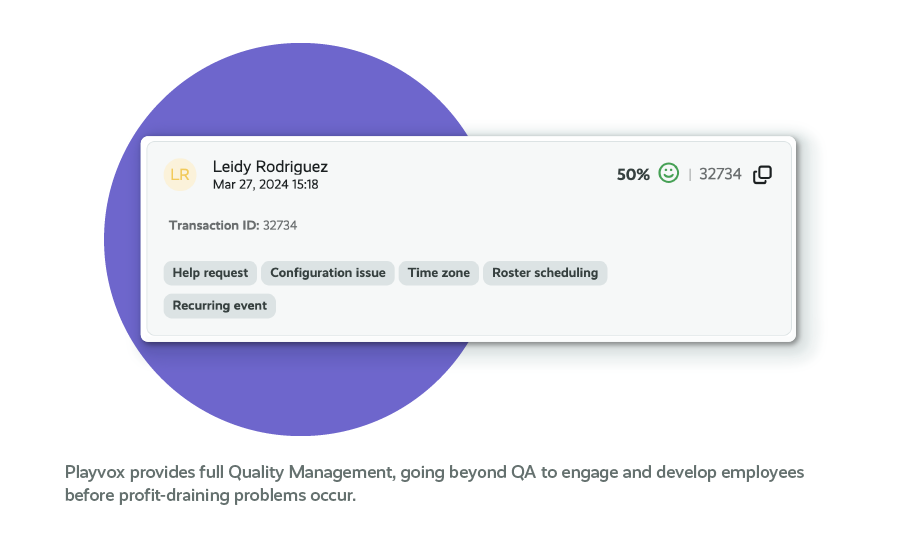AI in Customer Experience: Insights from Quality Management and Other Contact Center Solutions
Artificial Intelligence (AI) has been written about increasingly frequently in the past year. There is probably one area where there are more expectations for AI than in customer experience. This makes sense since in many companies, contact centers are seen as a cost center so those operating call centers or holding support centers under their P&L are always searching for ways to take costs out of the business.
A recent article on Forbes.com, notes that “Goldman Sachs says AI could replace the equivalent of 300 million full-time jobs, most experts agree that customer service jobs will be augmented and automated but not replaced.” It also says that “by automating mundane tasks, AI could provide a better experience for customers with more self-service options and help fix some of the industry’s biggest problems, especially employee burnout and inefficiency.”
The promise of AI is significant. In this article, we’ll discuss the history of AI being used in a call center, how AI tools are being used today, and the future of AI in improving customer experiences.

Is AI New For Contact Centers?
Before we talk about AI in customer experience today, it is important to take a look back and understand how AI has been used in support centers already.
1. Workforce Management Solutions
Anyone who has worked in a service center for a long time is familiar with the teams of people, number of spreadsheets, and the hundreds of hours that have traditionally gone into creating schedules. There is the initial analysis of determining when customer interactions come in (the hours when it is the busiest), another analysis of which team members are available when (noting special circumstances such as when certain agents need to leave or any other schedule limitations), and then matching all this together to optimize schedules to deliver the agreed-upon service level agreements (SLAs) for response time, wait time, and first contact resolution (FCR).
One of the early ways that AI was leveraged was to optimize all of the steps above via a modern workforce management solution (WFM). WFM solutions, like the one offered by Playvox, automates the entire process outlined above and takes into account the most accurate real-time data to produce a schedule for your agents that accounts for hours and number of people needed and the differences in agent availability – all optimized to create customer experiences in accordance with agreed-upon SLAs. This optimization is all done using AI and Playvox’s WFM has incorporated AI since the inception of the product over five years ago.

2. Chatbots
Another tool that has been in use for a few years is chatbots. These AI-powered virtual assistants can provide immediate responses to customer queries, offer product recommendations, and even help with troubleshooting common issues. Chatbots can handle multiple customer conversations simultaneously, reducing wait times, and improving overall customer satisfaction.
While chatbots might have initially been used for routine questions, with pre-loaded FAQs, they are becoming increasingly sophisticated with the ability to handle more complex inquiries every day.
One of the key ways AI is transforming customer experience is through chatbots. These AI-powered virtual assistants can provide immediate responses to customer queries, offer product recommendations, and even help with troubleshooting common issues. Chatbots can handle multiple customer conversations simultaneously, reducing wait times, and improving overall customer satisfaction.
3. Personalized Customer Experiences
Personalized customer experiences aren’t new, nor is the ability of AI to create these kinds of experiences. A couple of examples include:
- Using AI to offer up relevant articles on a website that relate to an article the website visitor has already downloaded. In this case, a database saves information about a customer / their on-line identity and what they might have searched for or downloaded in the past, and then serves up similar types of resources to match previous inquiries.
- Matching the caller ID with a record in Salesforce: Through robust integrations with Salesforce, this type of AI lets a contact center agent greet a customer by name as their phone number “pops” in the agent’s CRM when the contact calls. This has been in use for many years, and although it might seem pretty basic, it is still AI in action in the typical contact center.

4. Whisper Technology
“Whisper” technology is when an AI-type assistant is “listening” to an agent calls and suggests the right resource, answer, or helps to correct an agent via a “whisper” into their technology. Not so long ago, this also could have been a supervisor remotely monitoring the call or interaction and suggesting something to make the interaction better for the customer. The long-standing problem with this kind of technology is that when you send an agent too many queues or suggestions and they aren’t found to be helpful, the agent either ignores or turns off the technology altogether. This is similar to help desk articles that might pop-up, crowding an agent’s screen and making it difficult for them to do their job due to the constant distractions of “helpful” technology. We don’t often hear of this technology today, but this is another example of AI-type functionality that has been in use for a very long time.

AI in Customer Experience: A Look Ahead
As you’ve seen, AI in the contact center isn’t a new concept. From AI-driven WFM to chatbots and personalization, AI is already widely being used. Now let’s talk about near-term opportunities to leverage AI in customer experience.
1. Sentiment Analysis
Sentiment analysis is understanding the feeling the customer had when a particular interaction ended. You can look at whether the customer interaction was rated positive, negative, or neutral by the words the customer used in their text-based interaction. This is different from something like Net Promoter Score (NPS) which tells you the likelihood of a customer recommending your product or service to a friend or colleague. While both NPS and sentiment analysis are important, they enable you to understand customer experience in different ways. You can dig deep into customer sentiment by team, agent, or topic to gain a much broader understanding of the experience of your typical customers and their interactions with your agents than something like NPS alone.
In fact, positive customer sentiment and/or experiences leads to increased brand loyalty and spend. A study by Deloitte showed that customers are willing to spend 140% more after having a positive customer experience.
2. Automated Quality Management (AQA)
Quality Management has been around for as long as many veteran call center managers and leaders can remember. It is the process of scoring a statistically significant number of interactions by each agent and is usually done at least monthly by a team lead, supervisor, or quality analyst. It uses a scorecard and may score things such as greeting and closing, resolution of customer’s issue or problem, speed of responsiveness, and anything else that can add or take away from optimal customer experiences.

With something like AQA, this entire process is automated. Playvox AutoQA is a collection of functionality that lets you get the full picture of what is driving customer interactions with your business and also identifies the underlying sentiment. AutoQA provides AI to assist your analysts with scoring to drive a more efficient scoring and feedback process, but also allows your team to gain confidence in the results.
AQA is the exact type of solution that pundits and industry analysts speak about when they think of AI in customer experience. With AQA, you can improve customer experience because you can spend more time fixing problems rather than simply identifying the problems you might have. And, with something like AQA, you can look at all of your text-based interactions, rather than a small subset of 2-3% of interactions that most contact centers typically review.

Want to learn more about how you can infuse AI into your quality management process? View this webinar today!
3. WFM Powered By Your Agents
Forbes.com notes that “working in customer service is notoriously stressful—it was named one of the world’s top 10 most stressful jobs—and companies see turnover rates of up to 45% of agents every year. That has led to a massive talent shortage and is costly for companies to continually recruit and train new employees—all of which affects the customer and employee experience.”
While it is difficult to stay upbeat and engaged when faced with angry or dissatisfied customers day after day, unpredictable or inflexible schedules can also wear on agent engagement. That’s why analysts like Donna Fluss of DMG Consulting say that, “Employees want the flexibility to set and modify their schedules, lunches, and breaks. And agents do not want to be required to accept overtime or early leave at the discretion of their managers.”
The WFM solutions of the future will lean more on agents’ wants and needs, while also aligning with customer experience expectations. While systems of the past focus on determining SLAs needed, and then staffing and scheduling to match this, solutions of the future will determine the SLAs and optimize for agent satisfaction – offering more flexibility and things like easy shift swaps to improve agent engagement and motivation.

A Final Note On The Future of AI In Customer Experiences
Companies are reaching for AI to improve efficiency, lower costs, and improve customer experiences. With all of the recent excitement of the promise of AI, it is easy to forget that AI has been around the contact center industry for a long time. As you look to incorporate AI into your support center, remember that that AI solution alone won’t magically fix any issues or problems you may have today. Make sure you involve a trusted partner who can be with you for the long-term to help you experiment, leverage, and implement AI in a way that will improve your overall operations, while also taking care to not disrupt anything that might be working now. The future of customer experience will likely be the use of more AI tooling, but used deliberately and thoughtfully.







